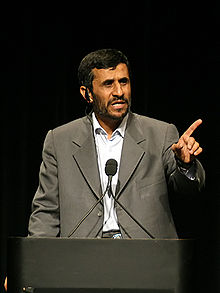Government of Mahmoud Ahmadinejad (2005–13)
| Mahmoud Ahmadinejad محمود احمدینژاد |
|
|---|---|
 |
|
| President of Iran | |
|
In office 3 August 2005 – 3 August 2013 |
|
| Vice President |
Parviz Davoodi Mohammad Reza Rahimi |
| Leader | Ali Khamenei |
| Preceded by | Mohammad Khatami |
| Succeeded by | Hassan Rouhani |
| Personal details | |
| Born |
28 October 1956 Aradan, Iran |
| Political party | Alliance of Builders |
| Other political affiliations |
Islamic Society of Engineers |
| Spouse(s) | Azam Farahi |
| Alma mater | Iran University of Science and Technology |
| Profession | Civil engineer |
| Religion | Islam |
| Signature |  |
| Website | http://www.president.ir |
The Government of Mahmoud Ahmadinejad consists of the 9th and 10th governments of the Islamic Republic of Iran. Ahmadinejad's government began in August 2005 after his election as the 6th president of Iran and continued after his re-election in 2009. Ahmadinejad left office in August 2013 at the end of his second term. His administration was succeeded by the 11th government, led by Hassan Rouhani.
In Iran Mahmoud Ahmadinejad's government has seen controversy over policies such as his 2007 Gas Rationing Plan to reduce the country's fuel consumption, and cuts in maximum interest rates permitted to private and public banking facilities; his widely disputed and protested election to a second term in 2009; and over the presence of a so-called "deviant current" among his aides and supporters that led to the arrest of several of them in 2011. Abroad, his dismissal of international sanctions against Iran's nuclear energy program, and his call for an end of the state of Israeli and description of the Holocaust as a myth, has drawn criticism.
Ahmadinejad was not widely known when he entered the presidential election campaign, although he had already made his mark in Tehran for rolling back earlier reforms. He is a member of the Central Council of the Islamic Society of Engineers, but his key political support is inside the Alliance of Builders of Islamic Iran (Abadgaran or Developers).
Ahmadinejad generally sent mixed signals about his plans for his presidency, perhaps to attract both religious conservatives and the lower economic classes. His campaign slogan was: "It's possible and we can do it".
In the campaign, he took a populist approach. He emphasized his own modest life, and compared himself with Mohammad Ali Rajai, Iran's second president. Ahmadinejad said he planned to create an "exemplary government for the people of the world" in Iran. He was a "principlist", acting politically based on Islamic and revolutionary principles. One of his goals was "putting the petroleum income on people's tables", meaning Iran's oil profits would be distributed among the poor.
...
Wikipedia
